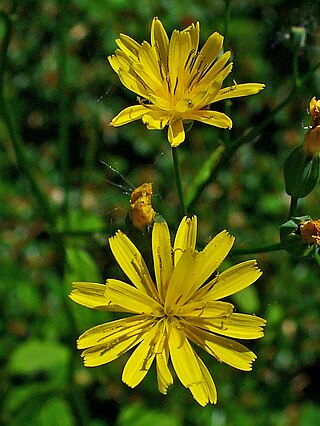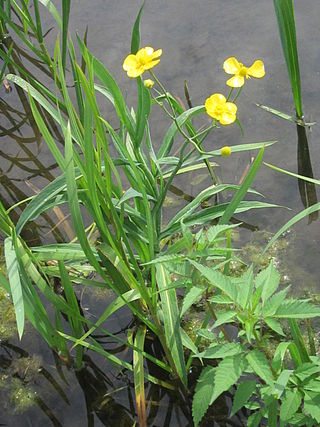
Euphorbia esula, commonly known as green spurge or leafy spurge, is a species of spurge native to central and southern Europe, and eastward through most of Asia north of the Himalaya to Korea and eastern Siberia. It can also be found in some parts of Alaska.

Ranunculus repens, the creeping buttercup, is a flowering plant in the buttercup family Ranunculaceae, native to Europe, Asia and northwestern Africa. It is also called creeping crowfoot and sitfast.

Lapsana communis, the common nipplewort, is a species of flowering plant in the family Asteraceae. It is native to Europe and southwestern Asia, and it is widely naturalized in other regions including North America.

Elymus repens, commonly known as couch grass, is a very common perennial species of grass native to most of Europe, Asia, the Arctic biome, and northwest Africa. It has been brought into other mild northern climates for forage or erosion control, but is often considered a weed.

Scheuchzeria palustris, is a flowering plant in the family Scheuchzeriaceae, in which there is only one species and Scheuchzeria is the only genus. In the APG II system it is placed in the order Alismatales of the monocots.

Ranunculus aquatilis, the common water-crowfoot or white water-crowfoot, is a plant species of the genus Ranunculus, native throughout most of Europe and western North America, and also northwest Africa.

Pyrola media, the intermediate wintergreen, is a flowering plant in the genus Pyrola, native to northern and eastern Europe and Western Asia.

Calystegia silvatica is the largest species of bindweed and is a strong rampant climber. It is native to southern Europe but has been introduced to many other areas because it is an attractive garden plant. Calystegia silvatica subsp. fraterniflora(Mack. & Bush) Brummitt is native to North America.

Montia fontana, blinks is a herbaceous annual to perennial plant that grows in freshwater springs in upland regions, and in seasonally damp acid grassland in the lowlands. It is widespread throughout the world, except in southern Asia. It is rather variable in morphology, which is reflected in a complex history of taxonomy. Currently, there are three accepted subspecies which are defined largely by the appearance of the seedcoat. It is edible and consumed as a salad in some areas, but is otherwise of minimal economic impact. Because of its association with clean water habitats, it is often viewed as a species of conservation value.

Ranunculus fluitans is a species of buttercup. It is a perennial water plant, which when in favourable conditions can grow up to 6 m (20 ft) height.

Lemna gibba, the gibbous duckweed, swollen duckweed, or fat duckweed, is a species of Lemna (duckweed). It has a simple plant body, known as a thallus, which floats on the surface of the water and measures 3–5 mm (0.12–0.20 in) in diameter. A single root hangs down into the water. Found in a wide range of still or slow-flowing water bodies, this common duckweed can also grow on mud or damp rocks.

Oenanthe pimpinelloides is a species of flowering plant in the family Apiaceae known by the common name corky-fruited water-dropwort. It is a plant of damp or dry grassland and more ruderal tall herb communities.

Pilularia globulifera, or pillwort, is an unusual species of fern in the family Marsileaceae. It is native to western Europe, where it grows at the edges of lakes, ponds, ditches and marshes, on wet clay or clay-sand soil, sometimes in water up to 30 cm (12 in) deep.

Ranunculus trichophyllus, the threadleaf crowfoot, or thread-leaved water-crowfoot, is a plant species in the genus Ranunculus, native to Europe, Asia and North America.

Helleborus viridis, commonly called green hellebore, is a species of flowering plant in the buttercup family Ranunculaceae, native to Central and Western Europe, including southern England. All parts of the plant are poisonous.

Ranunculus lingua, the greater spearwort, great spearwort, tongue-leaved crowfoot, or water buttercup, is a plant species in the family Ranunculaceae native to temperate areas of Europe, Siberia and through to the western Himalayas. It is a semiaquatic plant that prefers to grow in about 40 cm (16 in) of water in a variety of wetland habitats. A cultivar called 'Grandiflorus', the large-flowered greater spearwort, has 6 cm flowers and is favored by gardeners.

Veronica catenata, the pink water speedwell, is a species of flowering plant in the family Plantaginaceae. It is native to Canada, the United States, Europe, the Azores, and northern Africa. As its common name implies, it prefers growing in or near marshes, rivers, lakes and ponds.

Ranunculus tripartitus is a species of flowering plant in the family Ranunculaceae, which grows in pools and muddy hollows in coastal parts of Europe, North Africa and West Asia. It is rare and endangered throughout its range, and is considered to be an indicator of favourable environmental conditions.

Ranunculus baudotii, brackish water-crowfoot, is a flowering plant in the Ranunculaceae. As the name suggests, it tends to grow near the sea, typically in pools and ditches in coastal marshes that are slightly salty due to sea spray. It can also be found inland where there is some saline influence. It is not edible and has economic uses, but it is generally valued as a plant of conservation interest and an indicator of less agriculturally improved habitat.

Ranunculus hederaceus is a flowering plant in the family Ranunculaceae.





















